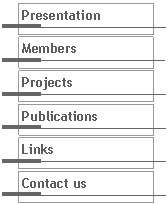|
Projects |
|
Reliability: Research Lines — Machine Design Research Group Department of Mechatronics and Mechanical System Escola Politécnica da Universidade de São Paulo |

|
Reliability Laboratory |
|
Research Lines — Machine Design Research Group |
|
Presentation | Members | Projects | Publications | Links | Contact us |


|
Title |
Availability Analysis of Power Generation Systems |
|
|
Coordinator |
||
|
|
gfmsouza@usp.br |
|
|
Keywords |
Availability, power generation, maintenance |
|
|
Sponsors |
CNPq – Brazilian Council of Science and Technology ANEEL – Electric Power Generation Regulatory Agency |
|
|
Graduate Students |
Idélcio Alexandre Palheta Cardoso (Doutorado), Fernando Jesús Guevara Carazas, |
|
|
Undergraduate Students |
||
|
Description |
For most systems there are three classes of maintenance, and at least one of which may be applied. In preventive or predictive maintenance, parts are replaced, lubricants changed, or adjustments made before failure occurs. The objective is to reduce the possibility of system deterioration, reducing the reliability decreasing rate over the long term by staving off the aging effects of wear, corrosion, fatigue, and related phenomena. In contrast, repair or corrective maintenance is performed after failure has occurred in order to return the system to service as soon as possible. The primary criteria for judging the effectiveness in maintenance procedures are the reduction of an equipment reliability-decreasing rate. Those criteria do not consider the economical relation between maintenance procedure and equipment reliability. The amount and type of maintenance that is applied in equipment depend strongly on its costs as well as the cost and safety implications of system failure. This problem is very complex if we consider a hydroelectric power plant. The hydrogenerator is a system composed of many sub-system and equipment that must operate in a proper and harmonic way in order to perform the hydrogenerator main function, which is transform hydraulic energy in electric energy. For an electric power generator company, the profit is directly related to the cumulative number of operational hours of the hydrogenerator. The operational availability of the hydrogenarator is related to its reliability, defined as the probability that a system will perform properly for a specified period of time under a given set of operating conditions. In order to reduce the reliability decrease, a proper maintenance policy should be selected for the hydrogenerator, aiming the reduction of the rates of failure. Taking in view that the operator’s maintenance program has some objectives such as to ensure realization of the inherent safety and reliability levels of the equipment, to restore safety and reliability to their inherent levels when deterioration has occurred and to accomplish these goals at a minimum total cost, including maintenance costs and the costs of residual failures, a reliability-based decision making process as for maintenance policy selection could be applied to achieve those goals. This decision process is named Reliability-Centered Maintenance. One of the chief drawbacks of the old hard-time approach to scheduled maintenance is that the resulting teardown inspections provided no real basis for determining when serviceable parts were likely to fail. More than any other single factor, recognition of the specific need to identify potential-failure conditions has been responsible for the change from scheduled overhauls to on-condition inspections for signs of imminent failure. In short, the driving element in all maintenance decision is not the failure of a given item, but the consequences of that failure for the hydrogenerator as a hole. Within this context it is possible to develop an efficient scheduled-maintenance program, subject to the constraints of satisfying safety requirements and meeting operational-performance goals. The RCM method intends to solve the problem based on the Failure Mode and Effects Analysis of equipment, in this case the hydrogenerator, and based on a decision-making diagram, which accounts for safety and economic consequences related to a given potential failure mode of a component. |
|